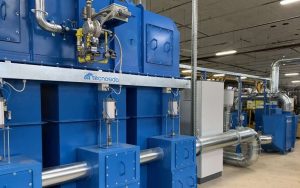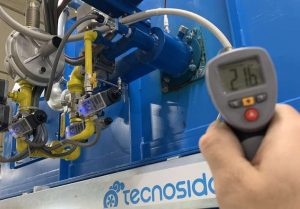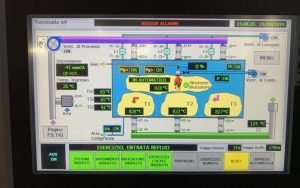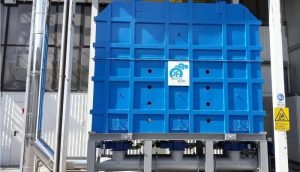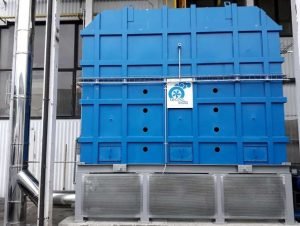Regenerative Thermal Oxidizers for VOC and fume abatement: applications and benefits
Thermal oxidation of Volatile Organic Compounds
Application 1: VOCs oxidation in the automotive industry
The customer of this case history is one of the world leaders in the manufacturing of fluid transport systems for the automotive industry (connectors and similar).
Gallery
The current production process implies the coating of the components. During this phase, VOCs and fumes are emitted into the atmosphere. The management of the Italian branch contacted Tecnosida® requesting the design and manufacturing of a Regenerative Thermal Oxidizer (RTO) to solve the problem.
Regenerative thermal oxidizer for VOCs and fumes from the coating process
After a first contact with the company, Tecnosida® planned a technical-commercial inspection to assess the situation and to precisely understand the customer’s needs.
In this first phase, it emerged that a thermal oxidizer was already present at the production site, which could not be properly used due to some issues. For this reason, Tecnosida® technicians inspected the existing RTO and highlighted two aspects:
- accumulation of material = the pollutant in the airflow to be treated, initially at aerosol state, changed its state following the contact with the combustor and the changes in temperature. The condensate produced by the pollutants on the walls of the pipes was dragged towards the RTO. This caused accumulation of material in the lower part of the system with consequent mechanical problems for the valves;
- high concentration of dust = Tecnosida® technicians found a high concentration of dust inside the ceramic beds. This was due to the thermal degradation of the pollutant while passing through the ceramic exchanger.
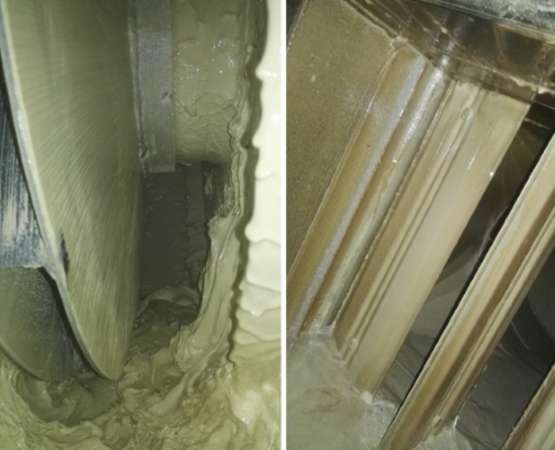
Based on the technical inspection outcome, Tecnosida® performed maintenance to reduce the customer’s problem and planned the future modification work. In the next paragraph, we will describe the RTO manufactured by Tecnosida®.
Technical features of the regenerative thermal oxidizer installed in Liguria
During the design phase of the treatment plant, Tecnosida® manufactured a pre-treatment system to solve the above-described accumulation of condensed material. This system eliminates the condensates before their entrance in the thermal oxidizer.
In particular, this system is composed of two phases:
- gaseous stream separation trap = the airflow resulting from the production process is conveyed into a settling chamber to reduce the speed of the airflow and allow the condensates to precipitate in the collector placed under the trap;
- rotary filters = a system composed of two rotary filters (an operational one and a back up one) is installed after the trap. This system further filters the pollutant in the gaseous stream in an aerosol state. Specifically, the airflow which has been previously treated inside the trap is then conveyed into the rotary filter and it flows through a coil of filtering material which retains pollutants. The operation of the rotary filters is automatically managed by a pressure switch, which replaces the dirty section of the filter with a clean one based on the pressure drops. Once the coil is entirely worn out, the flow is automatically redirected towards the backup rotary filter, allowing maintenance (coil replacement) on the main one.
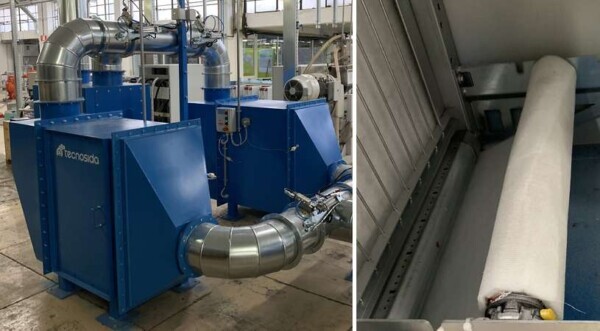
After the pre-filtering phase, the effluent is sucked by the process fan and transported into the regenerative thermal oxidizer through the flanged circular piping. The RTO manufactured for this application is composed of a combustion chamber, three ceramic exchangers, one methane burner and a control board for the automatic management of the valves placed at the side of the machine. The filtering media are made of Honeycomb material composed of ordered blocks with a high exchange surface, allowing greater thermal efficiency.
Below are the main RTO data:
| Regenerative Thermal Oxidizer | |
| Treated pollutants | VOCs and fumes inclined to create colloidal aerosols and dust |
| Flow rate | 1.500 Nm3/h |
| VOCs combustion temperature | 750°C |
| Residence time | s > 0,8 |
| Methane heating value | 8.600 Kcal/Nmc |
| Burner thermal power | 100.000 Kcal/h |
| Process fan power | 4 kW |
To guarantee a high abatement efficiency and the correct sizing of the thermal oxidizer, Tecnosida® engineers have considered three essential factors for VOC oxidation:
- temperature: to allow the correct oxidation of compounds, it must be kept over 750 °C. To achieve this, two aspects can be taken advantage of:
- heat produced by VOCs during oxidation;
- the methane burner, which emits auxiliary heat to reach and keep the required temperature
- time: the pollutant residence time inside the combustion chamber varies according to the type of VOC. In this application, the residence time is 0.8 seconds but if complex hydrocarbons are present, it can increase to 2 or more seconds;
- turbulence: this parameter indicates how well mixed and moving the molecules inside the effluent are. The turbulence value between oxygen and the pollutants to be abated is particularly important.
The plant has been manufactured in compliance with the reference BAT (PC.T.02) and it reduced emissions, falling within the limits established by the law and solving the customer’s problems.
Regenerative thermal oxidizers for VOC and fumes: remote management system
As disclosed in the previous paragraph, a constant temperature of 750-800°C is necessary to guarantee VOCs abatement. This temperature is reached by using a methane burner and it is kept constant thanks to the heat produced by organic compounds during oxidation. To keep this value under control and avoid energy waste, Tecnosida® created a remote management system to monitor all temperatures (from the entrance to the exit one, included the temperature inside the single chambers). As shown in the image aside, the PLC screen shows in real time the data regarding the pre-filtering system, the Regenerative Thermal Oxidizer (RTO) and its components. Thanks to the remote management system, it is possible to have a complete overview of the plant and to immediately intervene to optimize its operation.

Application 2: VOC oxidation in the abrasives industry
The customer of the second application specializes in the manufacturing of plastic abrasive media (grinding wheels for metal finishing, refractories for aluminium production and similar). The company contacted us because of the high quantity of styrene emitted during the normal production process, which exceeded the limits established by the current directives.
Regenerative thermal oxidizers for VOCs and fumes (styrene) in Piedmont
After an appropriate technical inspection, Tecnosida® established the necessary measures to manufacture an adequate Regenerative Thermal Oxidizer to solve the customer’s problem.
The operation of the thermal oxidizer used in this application is similar to the previously described one. In this case, however, the plant did not use substances which create accumulation inside the machine, therefore a pre-filtration system was not necessary. The airflow sucked by the production machines is directly conveyed into the RTO through a piping network and a tight-sealing butterfly valve system installed in the lower part of the oxidizer.
As disclosed in the previous part, the pollutant to be abated is styrene:
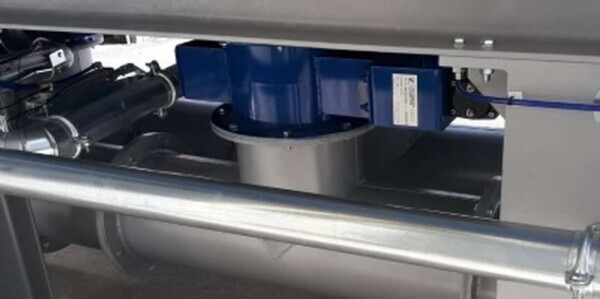
| Chemical formula | Molar Mass (g/mol) | Heating Value (Kcal/Kg) | Autoignition Temperature (°C) | Water Solubility (g/l) | |
| Styrene | C8H8 | 104,15 | 9.600 | 490 | 0,24 |
To reach the emission values required by the directive, the combustion chamber is sized to operate with a combustion temperature of 750-770°C, keeping the effluent at this temperature for a residence time of 0.8 seconds. The positioning of the butterfly valves in the lower part of the RTO allows the vertical development of the plant, taking full advantage of the available spaces.
Below are data regarding the machine:
| Regenerative Thermal Oxidizer (RTO) | |
| Treated pollutant | styrene |
| Flow rate | 2.500 Nm3/h |
| Minimum operating temperature | 750°C |
| Maximum operating temperature | 950°C |
| Residence time | s > 0,8 |
| Burner thermal power | 150 kW |
| Methane heating value | 8.600 Kcal/Nmc |
| Process fan power | 5,5 kW |
The plant manufactured by Tecnosida® complies with the reference BAT (PC.T.02) and it solved the customer’s problem.
Application 3: manufacturing of flexible packaging
The customer is an important company that manufactures flexible packaging for the Italian and foreign markets. The manufacturing of flexible packaging implies the emission of fumes containing VOCs from the printing machine. The customer contacted us requesting the manufacturing of a system which could reduce the emitted pollutant concentration to respect the limits established by the law.
Regenerative Thermal Oxidizer:
After a thorough inspection of the operating conditions, Tecnosida® identified the correct application of the thermal oxidizer to eliminate almost all the pollutants. Specifically, the proposed system is a regenerative thermal oxidizer with three chambers, which can guarantee the highest operational and energy saving standards.
Regenerative thermal oxidizers for VOC and fume abatement: advantages
The advantages resulting from the installation of our thermal oxidizer include:
- reducing pollution under the limits established by the law;
- eliminating the auxiliary fuel consumption thanks to the dimensioning of the regenerative exchanger;
- fast installation without production downtimes for the customer;
- machine management system which does not require the presence of a technician for its operation.
The plant was manufactured in compliance with the reference BAT (PC.T.02) and reduced the pollutant emissions, solving the customer’s problems.
